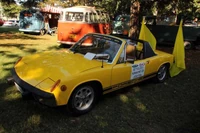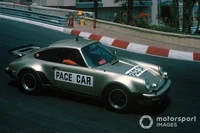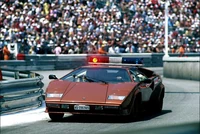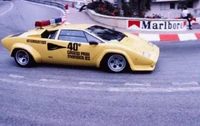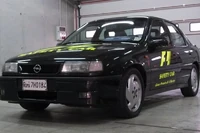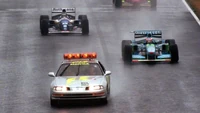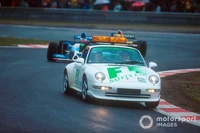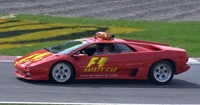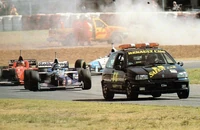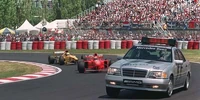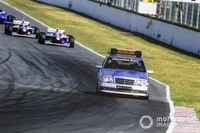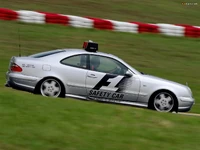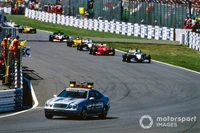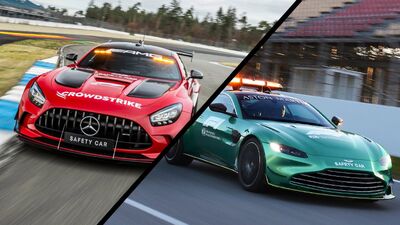
A safety car or pace car is a car which limits the speed of the cars on the track when the track is under caution conditions. The safety car is driven by a professional safety car driver, which is currently Bernd Mayländer.
Procedure
If an incident takes place on track, yellow flags may be put out for that sector or turn. However, if the incident may block the track, or leaves a lot of debris on track, the Safety Car may be deployed, to slow the drivers down while the marshals clear up. Before reaching the Safety Car, all drivers must slow down to a minimum delta, like with the VSC. Behind the Safety Car, drivers must not overtake and remain in position. This usually cools down brakes and tyres quite a bit, so to warm them up to optimum, drivers will often do burnouts and swerve from side to side, like with the formation lap. After all the debris is cleared, Race Control will give a signal that the Safety Car is coming in. Drivers will be notified by team radio, and also by the fact that the SC’s lights will turn off. When the SC peels into the pit lane, drivers will get up to racing speed, and when the next lap starts, green flags will be shown and the race resumes!
History
- Main article: Safety car driver
The safety car was first used during the 1973 Canadian Grand Prix and was driven by former Canadian race car driver Eppie Wietzes. When the car was first used, it took the incorrect position, placing a car 1 lap down. It took several hours after the race to determine the winner and sort out the confusion. The pace car would not be used again for another two decades.
The safety car was officially introduced during the 1993 season, in the Brazilian Grand Prix and the British Grand Prix.
Cars
| Year | Name | Image | Rounds | |
|---|---|---|---|---|
| 1973 | Porsche 914 | Canada | ||
| 1974-1975 | No safety car used | |||
| 1976 | Porsche 911 | Monaco | ||
| 1977-1980 | No safety car used | |||
| 1981 | Lamborghini Countach | Monaco | ||
| 1982 | Monaco | |||
| 1983 | Monaco | |||
| 1984-1992 | No safety car used | |||
| 1993 | Fiat Tempra | Brazil | ||
| Ford Escort RS Cosworth | Britain | |||
| 1994 | Opel Vectra | San Marino | ||
| Honda Prelude | Japan | |||
| 1995 | Porsche 911 GT2 | Belgium | ||
| Lamborghini Diablo | Canada | |||
| 1996 | Renault Clio | Argentina | ||
| Mercedes-Benz C36 AMG | Belgium | |||
| 1997 | Brazil-San Marino | |||
| Mercedes-Benz CLK 55 AMG (C208) | Monaco-Europe | |||
| 1998 | All | |||
| 1999 | All | |||
| 2000 | Mercedes-Benz CL 55 AMG | |||
| 2001 | Mercedes-Benz SL 55 AMG | |||
| 2002 | ||||
| 2003 | Mercedes-Benz CLK 55 AMG (C209) | |||
| 2004 | Mercedes-Benz SLK 55 AMG | |||
| 2005 | ||||
| 2006 | Mercedes-Benz CLK 63 AMG | |||
| 2007 | ||||
| 2008 | Mercedes-Benz SL63 AMG | |||
| 2009 | ||||
| 2010 | Mercedes-Benz SLS AMG | |||
| 2011 | ||||
| 2012 | ||||
| Mercedes-Benz SLS AMG GT | ||||
| 2013 | ||||
| 2014 | ||||
| 2015 | Mercedes-AMG GT S | |||
| 2016 | ||||
| 2017 | ||||
| 2018 | Mercedes-AMG GT R | |||
| 2019 | ||||
| 2020 | ||||
| 2021 | ||||
| Aston Martin Vantage | ||||
Safety car finishes
Very rarely, a race may finish behind the safety car due to accidents or incidents happening near the end of a race. There have only been nine times a race has finished behind the safety car to date:
- 1999 Canadian Grand Prix
- 2009 Australian Grand Prix
- 2009 Italian Grand Prix
- 2010 Monaco Grand Prix
- 2012 Brazilian Grand Prix
- 2014 Canadian Grand Prix
- 2015 Chinese Grand Prix
- 2019 Bahrain Grand Prix
- 2020 Bahrain Grand Prix
Notes
External Links
For more information about safety cars, check out this page
| v·d·e | Nominate this page for Featured Article |

